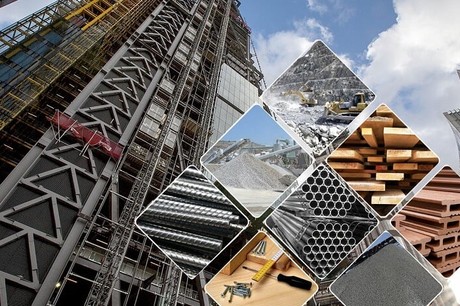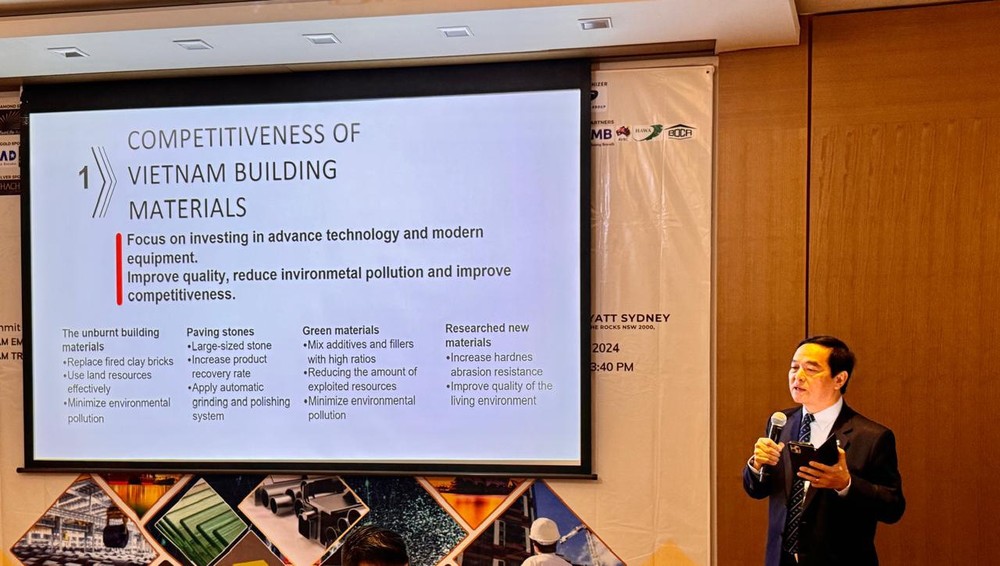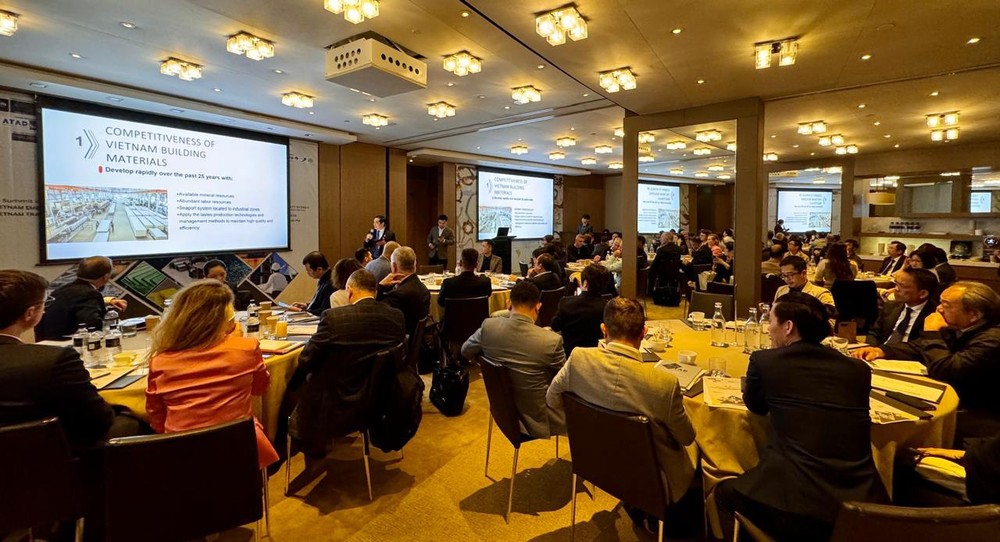Vietnamese construction materials are highly competitive when exported.

This is the comment of Mr. Le Viet Hai, Chairman of the Ho Chi Minh City Construction and Building Materials Association at the Vietnam – Australia Construction Materials Export Forum and Cooperation in Construction and Real Estate 2024 in Sydney (Australia) on May 15.
Exporting construction materials to more than 140 countries and territories
From a country that imported most of its materials, Vietnam has now produced construction materials that meet domestic construction needs and has a surplus of about 10-30% of its capacity for export. There are many factories that serve up to 90% of the foreign market.
 |
|
Mr. Le Viet Hai, Chairman of Ho Chi Minh City Association of Construction and Building Materials |
Currently, Vietnam’s construction materials industry has exported to over 140 countries and territories.
A typical example of the development of Vietnam’s construction material production and export capacity is cement export. According to the 2022 announcement of the US Geological Survey (USGS), Vietnam’s cement production capacity in 2022 will reach about 100 million tons, ranking 3rd in the world and especially ranking first in cement export. Large cement production enterprises in Vietnam include The Vissai Cement Group, Vicem Cement, etc.
Notably, Australia is an active market promoting the import of this item when spending more than 23.4 million USD to import 470,000 tons of clinker and cement from Vietnam, an increase of 135% in volume and 120% in value in 2023. According to the Vietnam Cement Association, although the demand for cement in Australia is increasing, due to high production costs, Australia still imports a large amount of cement from Vietnam every year.
Regarding the wood industry, each year, Vietnam exports an average of over 10 billion USD, ranking 5th in the world in wood processing and exporting and ranking highest in exporting to the US market. Vietnam’s wood products export market has expanded to over 120 countries and territories. The main processed products are interior, exterior, garden furniture and other products (such as wood chips, pellets). The main consumer markets are the US, EU, UK, Australia, Japan…
 |
|
Vietnamese construction materials enterprises attend the Vietnam – Australia Construction Materials Export Forum and Cooperation in Construction and Real Estate 2024 in Sydney (Australia). |
Currently, the ceramic tile industry in Vietnam has also risen to 4th place in the top 10 leading ceramic tile producing countries in the world and is the leader in ASEAN. According to the Vietnam Construction Ceramics Association, Vietnam has more than 80 ceramic tile manufacturing enterprises with a capacity of about 700 million m2/year. Regarding the shaping of ceramic tile products, some production facilities have used continuous pressing technology (Continua+ technology) to create large flat panels of over 5m2/panel; using digital color enamel printing technology for products with quality and aesthetics.
The steel industry has also recorded many breakthrough developments recently. Figures recently released by the General Department of Customs show that Vietnam’s total steel export output from the beginning of the year to mid-February reached 1.54 million tons, with a turnover of nearly 1.1 billion USD. Thus, compared to the same period in 2023, the amount of exported steel increased by 65%, while the turnover increased by 66.2%.
In recent years, the field of steel structure fabrication and installation in Vietnam has also made great strides. Vietnamese enterprises have invested in large factories with modern production line technology, machinery and equipment, and can provide complete solutions.
With the construction materials market expanding to many countries and territories, in recent years, the Vietnamese construction materials industry has focused on investing in advanced technology and modern equipment approaching major countries in the world, thereby improving quality, minimizing environmental pollution, and enhancing competitiveness in the international arena.
Vietnam’s construction materials products are increasingly diversified in types and designs, and their quality has been significantly improved, helping to enhance the competitiveness of Vietnamese construction materials enterprises compared to other foreign enterprises. Typical examples are Secoin cement bricks and A My quartz bricks.
It is predicted that in the near future, green materials will become popular and attract investors who tend to develop green buildings. The 4.0 industrial revolution has created opportunities for Vietnamese construction material manufacturing enterprises to make breakthroughs by applying technology to research and produce new, environmentally friendly materials.
Towards exporting comprehensive construction services
“Not only exporting construction materials, I believe that Vietnamese construction enterprises can also export comprehensive construction services abroad. That is, Vietnamese construction enterprises can completely become general contractors for real estate projects in Australia in particular and the world in general,” Mr. Le Viet Hai emphasized.
According to Mr. Hai, there are three factors that create the strength of Vietnamese construction enterprises. Firstly, the Vietnamese construction industry has developed strongly, Vietnamese construction enterprises possess the most advanced and diverse technical technology as well as construction management and business management methods, and possess the most modern machinery and equipment in construction.
Second, construction enterprises in Vietnam not only have core competitiveness in construction but also have advantages in supply chains in the most competitive construction industry. Third, the construction industry has abundant human resources, rich in the spirit of learning and innovation.
Why can Japanese, Korean and Chinese contractors export comprehensive construction services while Vietnamese enterprises cannot? Mr. Hai said that although they are quite confident when going abroad, Vietnamese enterprises also understand that there will be many challenges to overcome. The difficulty in the foreign construction market, especially in developed countries like Australia, is not price competition but the difficulties in technical and legal barriers in importing human resources, construction materials, construction machinery and equipment, etc., especially the issue of labor export.
Therefore, Vietnamese enterprises need to have a reasonable strategy, need to build a comprehensive and synchronous ecosystem, an environment of effective cooperation and mutual support between domestic construction enterprises and Vietnamese people abroad.
In addition, to successfully export the construction industry to the global market, support from both the Government and businesses is needed.
On the Government side, the Chairman of the Ho Chi Minh City Construction and Building Materials Association proposed solutions to support global market information, facilitate trade agreements, reform policy mechanisms and administrative procedures. At the same time, improve the quality of human resources according to international standards and create better conditions for domestic contractors to act as general contractors, establish an optimal business ecosystem for the industry…
For businesses, it is necessary to comprehensively restructure (products, markets, business models…), participate in international forums and exhibitions, and proactively connect and cooperate.
“The solution of exporting the construction industry abroad, once it becomes a reality, will bring huge benefits to the economy, to the Vietnamese construction industry in general and to businesses operating in this field in particular. This success will make construction a spearhead economic sector of the country,” Mr. Le Viet emphasized.


